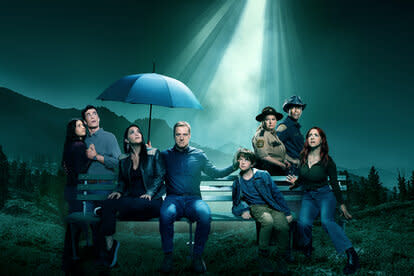Astronomers find the face of a cracked-out bear on the surface of Mars
In 1985, narcotics officer turned drug smuggler Andrew C. Thornton II dumped a whole bunch of cocaine out of his Cessna 404 before jumping out himself. If things had gone according to plan, Thornton would have parachuted to the ground and trucked back to where he dumped the drugs. Then he would have done whatever a person does with 70 pounds of cocaine. Instead, Thornton got caught in his parachute on the way to the ground and fell to his death, and he wasn’t the only casualty of that fateful drug run.
Thornton didn’t live to pick up his cargo and it was instead picked up by an incredibly unlikely party. Three months after Thornton’s death, investigators discovered a second body in the woods: the body of a 175-pound black bear affectionately known to some as Pablo Escobear. The bear was found beside a duffel bag which previously housed approximately 70 pounds of cocaine, all of which appeared to have been scattered or consumed.
RELATED: Wild party! The science behind 'Cocaine Bear' and other inebriated animals
In the real world, the bear died a lonely and probably confusing death without harming anyone or anything else. But when Cocaine Bear, the big screen adaptation of the story, hits theaters on Feb. 24, we’ll be treated to a much deadlier animal, coked out and hellbent on killing anyone in its path. It’s the sort of imagery which can only be imagined by the dreamers in Hollywood or the unsupervised forces at play on alien worlds.
It turns out, Mars has a cocaine bear all its own, at least according to an image recently released by the University of Arizona.
HiPOD: A Bear on Mars?
This feature looks a bit like a bear’s face. What is it really?
More: https://t.co/MpLQBg38ur
NASA/JPL-Caltech/UArizona#Mars #science #NASA https://t.co/2WUNquTUZH pic.twitter.com/1k2ZnLcJ5o— HiRISE: Beautiful Mars (NASA) (@HiRISE) January 25, 2023
Humanity is no stranger to seeing faces where none exist. In 1976, astronomers using NASA’s Viking 1 spacecraft were looking for landing sites for Viking 2 when they found a structure in a Martian region called Cydonia. That structure has a striking resemblance to a human face. The structure itself is roughly two miles from end to end and is actually an oddly shaped hill. When the light hits the hill just so and the shadows fall just right, crests and valleys in the hill conspire to appear briefly like a human face jutting out from beneath the Martian crust.
In the decades since its discovery, the face on Mars has inspired all manner of alien conspiracy theories and bizarre explanations, few of which are satisfied with the mundane (but almost certainly correct) geological explanation. If the face on Mars really is an alien entity doomed to stare unerringly into the cosmos, at least it’s no longer alone.
Using the High Resolution Imaging Experiment (HiRISE) camera on NASA’s Mars Reconnaissance Orbiter, operators at the University of Arizona snapped a photo of a previously unseen geological formation on the surface of Mars. The photo was taken Dec. 12, 2022 and released to the public Jan. 25, via the University of Arizona’s website.
The orbiter circles the planet every couple of hours, studying the atmosphere and climate while looking for potential future landing sites. It also takes a whole lot of pictures and sometimes they have striking geological structures that look like the faces of drug-crazed animals.
RELATED: Is ‘Cocaine Bear’ really based on a true story? Behold the wild tale of the real ‘Pablo Escobear’
A cursory glance at the image and even a little imagination reveal the presence of a moderately cracked bear-like face staring endlessly back at you. It is, undeniably, adorable and horrifying in equal measure. It looks like an anti-Paddington, like the last face you see before the final flicker of electricity fizzles out of your dying brain. And when you see it, you’re unsure if what awaits you is heaven or hell.
The face in the picture isn’t really a cosmic horror or a bear, or course. Its eyes are made of craters, punched out by conveniently spaced impactors from some distant past. The snout is a hill with a v-shaped collapse structure, making up the nose and mouth. It’s hypothesized that the snout could be an ancient volcano or mud vent which burbled and collapsed in just the right way. And the entire structure is surrounded by a ring which nicely encapsulates the head. That ring might be a fracture pattern caused by sediment settling over a larger, buried impact crater.
The point is, if you’re smuggling mind-altering substances (not an activity we recommend) don’t drop them on Mars. There’s no telling what could happen.
Don’t forget to check out Cocaine Bear when it hits theaters Feb. 24.

